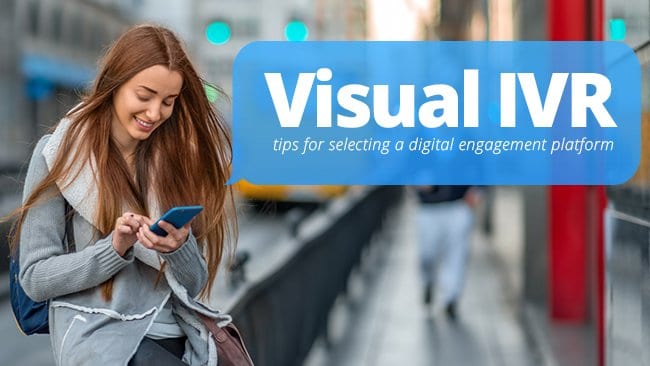

Visual IVR has gone mainstream. The widespread adoption of this digital technology is taking place rapidly. However, not all Visual IVR solutions are the same. Here’s what you should look for in a digital engagement platform.
Digital transformation is upon us. Consumers have shifted to digital engagement as the preferred communication methodology. In fact, “Generation Y” consumers overwhelmingly prefer digital communication with only less than 13% wanting to use the telephone! It should be readily apparent that your organization needs to be ready for the digital consumer.
Voice Isn’t Dead
What should be noted is that while consumers strongly prefer digital channels, it is just that: a preference. Unfortunately, far too often the digital experience or self-service interaction fails the user, requiring them to reach out for traditional assisted service: the phone. Studies show that despite the investment in digital IVR self-service technologies, approximately 82% of interactions still end up in your contact center (this is an average across verticals…your mileage may vary). Even organizations with good mobile apps still experience high call volume. And those interactions that started in self-service (ie. The digital channel) and end up with assisted service typically offer no continuity or context. In effect, the call starts completely cold, resulting in both customer frustration and longer call times.
1. Customer Adoption and Accessibility is Critical
No matter how compelling the solution, how great the benefits or the technology, if your customers don’t have easy access to the solution, it won’t be adopted and the project will fail. Native Apps are notorious for poor adoption. If you require a customer to download an app before they can get service, this is a sure-fire formula for limiting adoption. Even for customers that have installed your app, it has been shown that as time passes App usage diminishes…something we call App Decay. As one of our customers, a leading credit card issuer, stated: “Despite having a mobile app, we still received millions of calls into our contact center”. Customers forget about your app when they have a pressing issue at hand. However, a true Visual IVR solution not only doesn’t require an app, but it can also improve your native app adoption by reminding voice callers about your app, and even pivoting them back into the mobile app to increase awareness.
2. Channel Pivoting
When not focusing on “Generation Y”, and instead of taking a broader look at your customer base, we see an average of about 40% of consumers bypassing any self-service and simply picking up the phone and calling the organization. That is, using voice as their first preference. It’s no secret that voice calls are an organization’s most expensive form of assisted service. One way to reduce cost and increase call deflection is to channel pivot that expensive voice calls back into a digital self-service session. This provides an opportunity to resolve a customer’s inquiry on the less expensive digital channel. And if they still need assisted service, passing in the full context to the agent ensures the call gets off to a smooth start with lower handle times.
3. Collaboration
Assisted service interactions by way of desktop automation software often require collaboration to successfully complete the call. A mature digital engagement platform will allow the agent and customer to collaborate digitally while on the voice call! This means the agent can digitally send documents for signing, images, links, and more, all while talking to the customer.
Dual digital and voice collaboration ensures that calls are resolved correctly the first time, and reduces sales slippage by closing deals “then and there”.
4. One Graphical Designer for All Your Interactions
It is imperative that your subject matter experts can create your digital and voice interactions. By using a graphical designer to create your interactions, you make it far simpler and quicker to rapidly create your customer interactions. Perhaps more importantly, a single designer and runtime platform ensures full consistency of your interactions regardless of the channel the interaction is executing on. This means that your customers have consistency across all the channels and greatly assists in their ability to channel hop.
Whether you’re running your interactions on the web, mobile, social, kiosk, or via an Internet-enabled device (IoT), one designer should rule them all.
5. Blending Digital and Voice
Despite the world going digital, we know that currently 82% of customer interactions still end up in the contact center.
It is imperative to provide seamless connectivity from the digital to the voice channel, with no repeating of information, and the agent having full context of the customer’s interaction. This ensures prompt resolution, lowers the customer’s effort, and lowers call handle times.
6. Channel and Infrastructure Agnostic
The reality of the enterprise landscape is that you have a mix of channels and infrastructure providers. You should be Choosing the best-of-breed for each channel and underlying line of business applications makes sound business sense. It is important therefore that your digital engagement platform is completely agnostic to the underlying technology.
Not only will that allow you to work with what you have in place, but it also provides you the freedom to subsequently change underlying providers. Be wary of solutions that require you to obtain everything from a single vendor.
7. Open Integration and Flexibility
The days of “proprietary” are over. Any enterprise deployment will require extensive integration within the environment, and the ability to extend and customize the solution. Whether you’re designing interactions for the web, the mobile web, or even native mobile, the platform you choose should provide all the relevant API for easy integration. In addition, the solution should allow you to choose a cloud-based solution or the ability to deploy on-premises for those environments that require it.
8. Omnichannel Agent Desktop
There is a lot of focus on providing your customers with an omnichannel experience. Providing consistency and continuity as customers hop from channel to channel is crucial. What organizations often neglect is ensuring the agent is equipped to handle the omnichannel customer. Ventana research states that the average agent now has to contend with 17 channels on their desktop! When you don’t properly equip your agents with the tools they need to manage these channels, the investment on customer-facing omnichannel solutions is highly diminished, as the experience breaks down when they reach an agent.
9. Reuse Your Digital Assets
Your digital engagement platform should reuse your digital assets as part of your digital transformation initiatives and deliver a better customer experience. Content management, knowledge bases, virtual desktop assistants … all should be “channel merged” … conveniently and seamlessly blended to drive the Next Best Action for digital engagement for your customer.
10. References
Many vendors claim to have a robust digital engagement platform. It is imperative that you check references to understand exactly where they have been deployed, the scalability, and how the vendor has helped the organization digitally transform. This will ensure you have a vendor with not only the right technology but also the right expertise.
11. Bonus Tip… Rapid Implementation
Implementing a digital engagement platform should reuse your existing assets and be up and running in weeks not months. This should include the ability to integrate seamlessly with your Voice IVR without requiring any changes on the Voice IVR. By reusing the Voice IVR interactions, Visual IVR can be realized in days or weeks.
[About the author]


